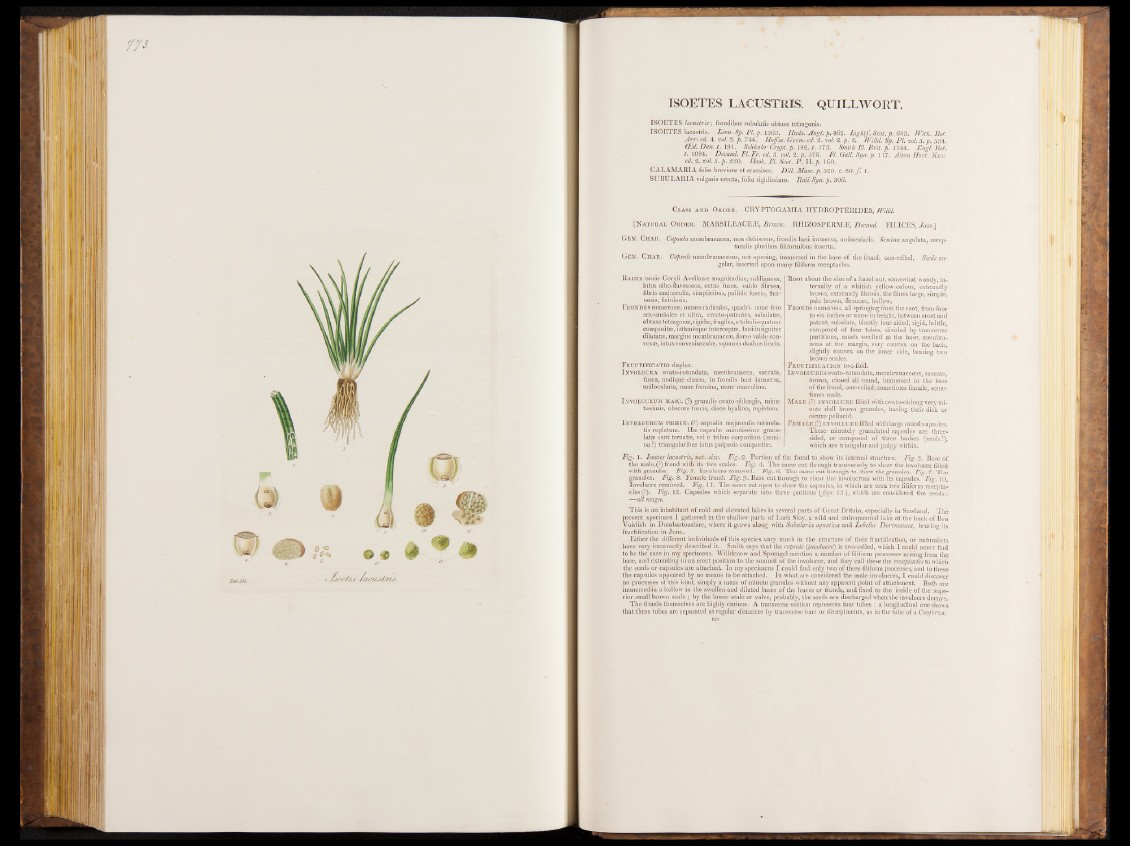
ISOETES LACUSTRIS. QUILLWORT.
ISOETES lacustris; frondibus subulatis obtuse tetragonis.
ISOETES lacustris. Linn. Sp. PI. p. 1563. Huds. Angl. p. 462. L ig h t f Scot. p. 683. With. Lot.
A r r . ed. 4. ml. 3. p. 744. Hoffm. Germ. ed. 2. ml. 2. p. 2. Willd. Sp. PI. ml. 5. p. 534.
(Ed. D an. t. 191. Schkuhr Crypt, p. 182. t. 173. Smith FI. B r it. p. 1144. Engl. Bot.
t. 1084. Decand. FI. F r. ed. 3. m l. 2. p. 576. Fl. Gall. Syn. p. 117. Alton Hort. Kew.
ed. 2. ml. 5. p . 530. Hook. Fl. Scot. P . I I. p . 160.
CALAMARIA folio breviore et crassiöre. Dill. Muse. p. 520. t. 80. f 1.
SUBULARIA vulgaris erecta, folio rigidissimo. R aii Syn. p. 306.
Class a n d Or d e r . CRYPTOGAMIA H Y D RO PT ERID E S , Willd.
[N atural Or d e r . MARSILEACE/E, Brown. RHIZOSPERREE, Decand. F IL ICE S , J im .]
Ge n . Ch a r . Capsula membranacea, non dehiscens, frondis basi immersa, unilocularis. Semina angulata, recep-
taculis pluribus filiformibus inserta.
Ge n . Ch a r . Capsule membranaceous, not opening, immersed in the base of the frond, one-celled. Seeds angular,
inserted upon many filiform receptacles.
Rad ix nucis Coryli Avellanæ magnitudine, sublignosa,
intus albo-flavescens, extus fusca, valde fibrosa,
fibris majusculis, simplicibus, pallide fuscis, flex-
uosis, fistulosis.
Frondes numéros», omnes radicales, quadri- nunc fere
sex-unciales et ultra, erecto-patentès, subulatæ,
obtuse tètragonæ, rigid», fragiles, e tubulis quatuor
composite, isthmisque intercepte, basi insigniter
dilatât», margine membranace»,dorso valde convex
», intus convexiusculæ, squamis duabus fuscis.
F ructificatio duplex.
I nvolucra ovato-rotundata, membranacea, saccata,
fusca, undique clausa, in frondis basi immersa,
unilocularia, nunc feemina, nunc masculina.
INVOLUCRUM MASC. (?) granulis ovato-oblongis, minu-
- tissimis, obscure fuscis, disco hyalino, replelum.
I nvolucrum poe m in . .(?) capsulis majusculis rotunda-
tis repletum. H » capsul» minutissime granula
te sunt ternatæ, vel e tribus corporibus (semi-
na ?) triangularibus intus pulposis composite.
Root about the size of a hazel nut, somewhat woody, internally
of a whitish yellow colour, externally
brown, extremely fibrous, the fibres large, simple,
pale brown, fiexuose, hollow.
Fronds numerous, all springing from the root, from four
to six inches or more in height, between erect and
patent, subulate, bluntly four-sided, rigid, brittle,
composed of four tubes, divided by transverse
partitions, much swelled at the base, membranous
at the margin, very convex on the back,
.slightly convex on the inner side, bearing two
brown scales.
F ru c t ifica t io n two-fold.
I nvolucres ovato-rotundate, membranaceous, saccate,
brown, closed all round, immersed in the base
of the frond, one-celled, sometimes female, sometimes
male.
Male (?) involucre filled with ovato-oblong very minute
dull brown granules, having their disk or
centre pellucid.
Female (?) involucre filled with large round capsules.
These minutely granulated capsules are three-
sided, or composed of three bodies (seeds?),
which are triangular and pulpy within.
Fig. 1. Isoetes lacustris, nat. size. Fig. 2. Portion Of the frond to show its internal structure. Fig. 3. Base of
the male.(?) frond with its two scales. Fig. 4. The same cut through transversely to show the involucre filled
with granules. Fig. 5. Involucre removed. Fig. 6. The same cut through to show the granules. Fig. 7. The
granules. Fig. 8. Female frond. Fig. 9■ Base cut through to show the involucrum with its capsules. Fig. 10.
Involucre removed. Fig. 11. The same cut open to show the capsules, in which are seen two filiform receptacles^?)*
Fig. 12. Capsules which separate into three portions (Jigs. 13.), which are considered the seeds:
— all magn.
This is an inhabitant o f cold and elevated lakes in several parts of Great Britain, especially in Scotland. The
present specimen I gathered in the shallow parts of Loch Sloy, a wild and unfrequented lake at the back of Ben
Voirlich in Dumbartonshire, where it grows along with Subularia aquatica and Lobelia Dortmanna, bearing its
fructification in June.
Either the different individuals of this species, vary much in the structure of their fructification, or naturalists
have very incorrectly described it. Smith says that the capsule (:involucre) is two-celled, which I could never find
to be the case in my specimens. Willdenow and Sprengel mention a number of filiform processes arising from the
base, and extending in an erect position to the summit of the involucre, and they call these the receptacles to which
the seeds or capsules are attached. In my specimens I could find only two o f these filiform processes, and to these
the capsules appeared by no means to be attached. In what are considered the male involucres, I could discover
no processes of this kind, simply a mass of-minute granules without any apparent point of attachment. Both are
immersed in a hollow in the swollen and dilated bases of the leaves or fronds, and fixed to the inside of the superior
small brown scale; by the lower scale or valve, probably, the seeds are discharged when the involucre decays.
The fronds themselves are highly curious. A transverse section represents four tubes : a longitudinal one shows
that these tubes are separated at regular distances by transverse bars or dissepiments, as in the tube of a Conferva.